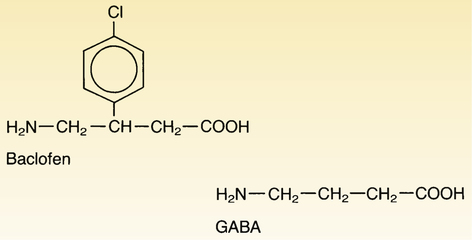CHAPTER 25 Treatment of spasm involves physical measures as well as drug therapy. Physical measures include immobilization of the affected muscle, application of cold compresses, whirlpool baths, and physical therapy. For drug therapy, two groups of medicines are used: (1) analgesic anti-inflammatory agents (eg, aspirin), and (2) centrally acting muscle relaxants. The analgesic anti-inflammatory agents are discussed in Chapter 71. The centrally acting muscle relaxants are discussed below. The family of centrally acting muscle relaxants consists of 9 drugs (Table 25–1). All have similar pharmacologic properties. Hence, we will consider these agents as a group. TABLE 25–1 Drugs for Muscle Spasm: Centrally Acting Muscle Relaxants Baclofen [Lioresal] acts within the spinal cord to suppress hyperactive reflexes involved in regulation of muscle movement. The precise mechanism of reflex attenuation is unknown. Since baclofen is a structural analog of the inhibitory neurotransmitter GABA (Fig. 25–1), it may act by mimicking the actions of GABA on spinal neurons. Baclofen has no direct effects on skeletal muscle.
Drugs for muscle spasm and spasticity
Drug therapy of muscle spasm: centrally acting muscle relaxants

Generic Name
Trade Names
Usual Adult Oral Maintenance Dosage
Baclofen
Lioresal
15–20 mg 3 or 4 times/day
Carisoprodol
Soma
350 mg 3 or 4 times/day
Chlorzoxazone
Paraflex, Parafon Forte DSC, Remular-S, Relax-DS
250 mg 3 or 4 times/day
Cyclobenzaprine
Flexeril, Fexmid
10 mg 3 times/day
Cyclobenzaprine ER*
Amrix
15 or 30 mg once daily
Diazepam
Valium
2–10 mg 3 or 4 times/day
Metaxalone
Skelaxin
800 mg 3 or 4 times/day
Methocarbamol
Robaxin
1000 mg 4 times/day
Orphenadrine
Banflex, Flexon, Norflex
100 mg morning and evening
Tizanidine
Zanaflex
4 mg 3 or 4 times/day
Drugs for spasticity
Baclofen
Mechanism of action
< div class='tao-gold-member'>
![]()
Stay updated, free articles. Join our Telegram channel

Full access? Get Clinical Tree


Drugs for muscle spasm and spasticity
Only gold members can continue reading. Log In or Register to continue
Get Clinical Tree app for offline access


